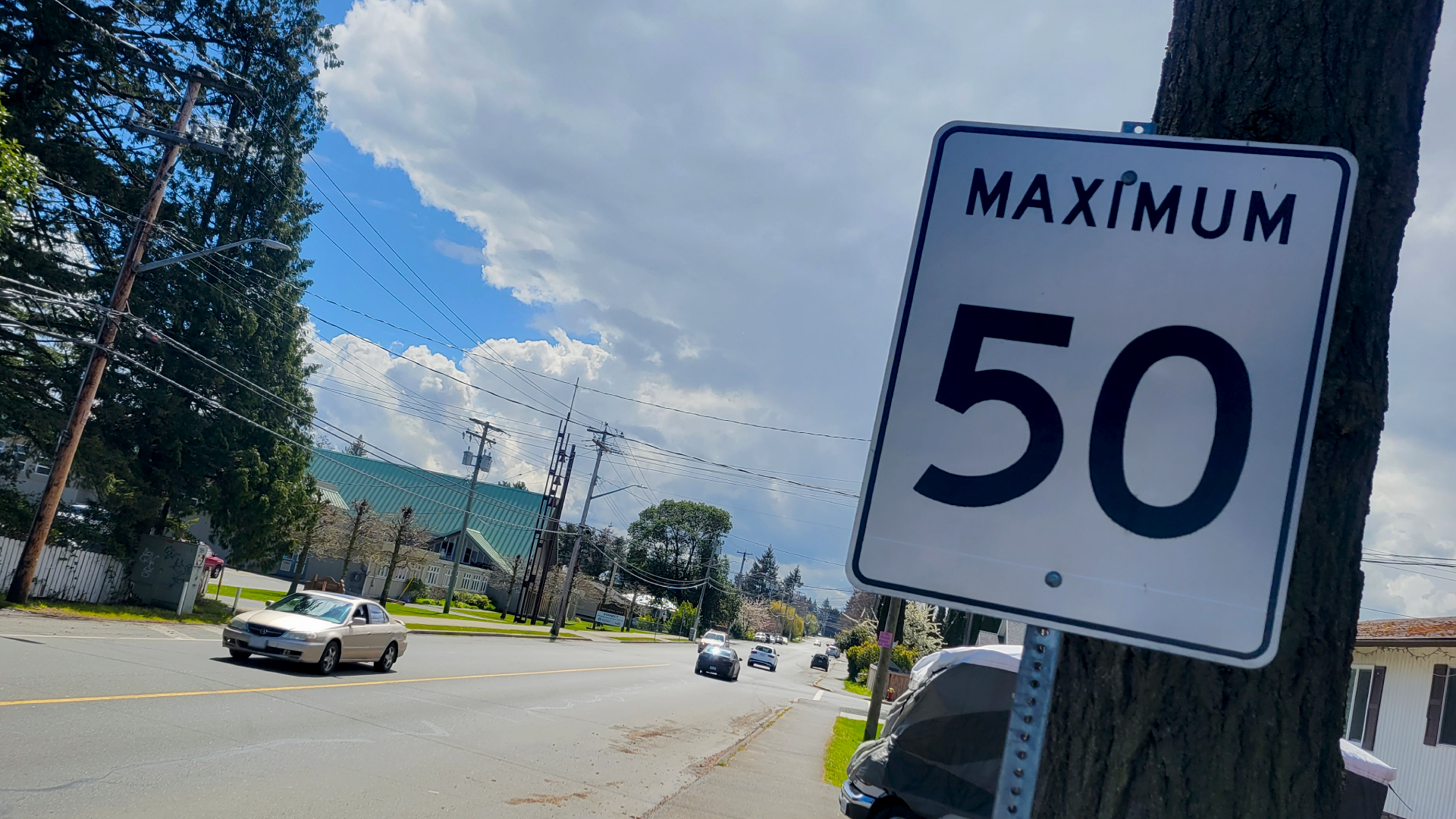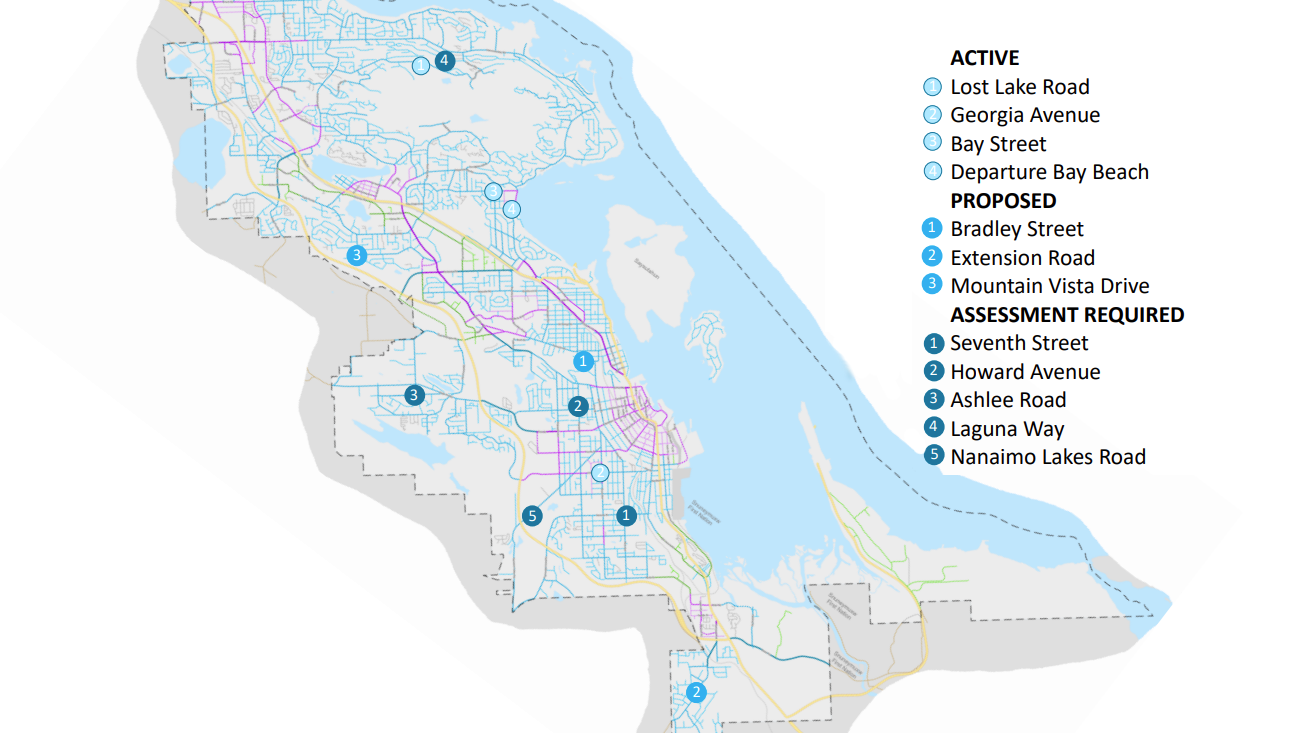NANAIMO — A new pilot project is being pitched to see how reducing vehicle speeds in certain neighbourhoods will improve pedestrian safety.
The future of a City staff-proposed $225,000 project will be decided by Council at a future meeting and would lower vehicle speeds to 30 or 40 kilometres per hour in three urban centres of Nanaimo: downtown, around NRGH and the University district.
Jamie Rose, city manager of transportation, told councillors at a special governance and priorities committee meeting on Thursday, April 21, the pilot would be neighbourhood wide, rather than just specific sections of roads like school or park zones.
“We are looking at these as blanket areas but there are going to be some roads that fall within those footprints that we do need to be conscious of how they operate. There may be some we need to make some decisions to exclude from it, but the vast majority will have some sort of speed reduction on them.”
Rose identified Bowen Rd., Wakesiah Ave., Fifth St. and Bruce Ave. as some of the main corridors which may need to be excluded from speed reductions, but no specific decisions have been made.
Also still somewhat up in the air are both the timeline for implementation and boundaries for the three urban centres, however it’s expected they would largely follow established outlines from past community and Council plans.
The purpose of Thursday’s presentation was to garner feedback from councillors ahead of the final pitch at an upcoming meeting.
It’s all in a bid to improve safety on area roads and create what City staff referred to as a “cultural shift” on dealing with excessive speeds and how residents get around.
The areas were chosen based on public feedback through past rounds of public consultation, including Reimagine Nanaimo.
“The majority of the locations that were identified as being a high priority were in these three urban centres,” Rose said. “We also felt these were very walking-friendly neighbouhoods already so the combination of those two plus the relatively grid like network appeared to be a very opportunistic place to start.”
 Under the proposal, 50 kilometre per hour zones would be replaced by 30 or 40 kilometre per hour signs in three urban centres throughout Nanaimo. (Alex Rawnsley/NanaimoNewsNOW)
Under the proposal, 50 kilometre per hour zones would be replaced by 30 or 40 kilometre per hour signs in three urban centres throughout Nanaimo. (Alex Rawnsley/NanaimoNewsNOW)For now, updated signage and a before and after study is expected to be the extent of the project, with any further steps related to traffic calming to potentially come after the pilot concludes.
“This really should be viewed as the first step in an incremental process towards enhancing road safety and we’ll take the lessons learned from it to see where to go next and what we can do to further improve things,” Rose added.
It’s expected ICBC will financially contribute in some way to the project, however the scope of their participation isn’t known yet.
Rose said over the last few years, more and more requests have come in from the public to survey speeds in their neighbourhoods, some of which can be dismissed quickly, but others get more study.
“There are a number of them…where we’ve actually gone out and collected the data and said there’s speeds that are well above of what we would expect to see on these roads. Are they generating collisions? Not yet, but we also know the higher the rate of speed when an MVA occurs, the lower the survivability for everybody.”
Barbara Thomas, assistant manager of transportation, added the proposed measures are something the City can do now, with the long term vision encompassing already established ‘complete streets’.
The updated designs, already used along Metral Dr., portions of Bowen Rd. and Front St. naturally reduce speeds according to Thomas.
“[As] these new road design standards are adopted and constructed, we’re going to see a change in speeds because the road will be self-explaining, but until that point in time we have to use other measures to retroactively control what people are doing.”
Money for the project would come from the $1 million Pedestrian Unallocated fund, money which is set aside each year for projects which improve pedestrian safety in the city.
Spending nearly a quarter of the budget on signage and study for speed reduction in three urban centres was raised as a concern by coun. Zeni Maartman.
“I really thought [the budget] was going towards pedestrian safety, sidewalks, traffic, the intersections… so I’m not leaning towards signage and studies. I was really wanting to put a million dollars, boom, into actual projects.”
 Traffic calming measures are either completed, underway or proposed throughout Nanaimo including lane narrowing, speed bumps and additional signage to reduce vehicle speeds. (City of Nanaimo)
Traffic calming measures are either completed, underway or proposed throughout Nanaimo including lane narrowing, speed bumps and additional signage to reduce vehicle speeds. (City of Nanaimo)Councillors also discussed ongoing work, which was approved in years previous, along with newly proposed projects for traffic calming along certain city streets.
Active studies and projects include surveys of Lost Lake Rd., Georgia Ave., Bay St. and along Departure Bay Beach where lane-narrowing concrete dividers were installed to limit space for vehicles to speed.
In addition to voting on the speed reduction pilot program, councillors will also make decisions on how to spend the rest of the unallocated project budget.
Proposed uses include accessibility and safety upgrades at a number of intersections as well as sidewalk and safety enhancements in Chase River along the Trans Canada Hwy. between Cranberry Rd. and Maki Rd.
Join the conversation. Submit your letter to NanaimoNewsNOW and be included on The Water Cooler, our letters to the editor feature.
alex@nanaimonewsnow.com
On Twitter: @alexrawnsley












